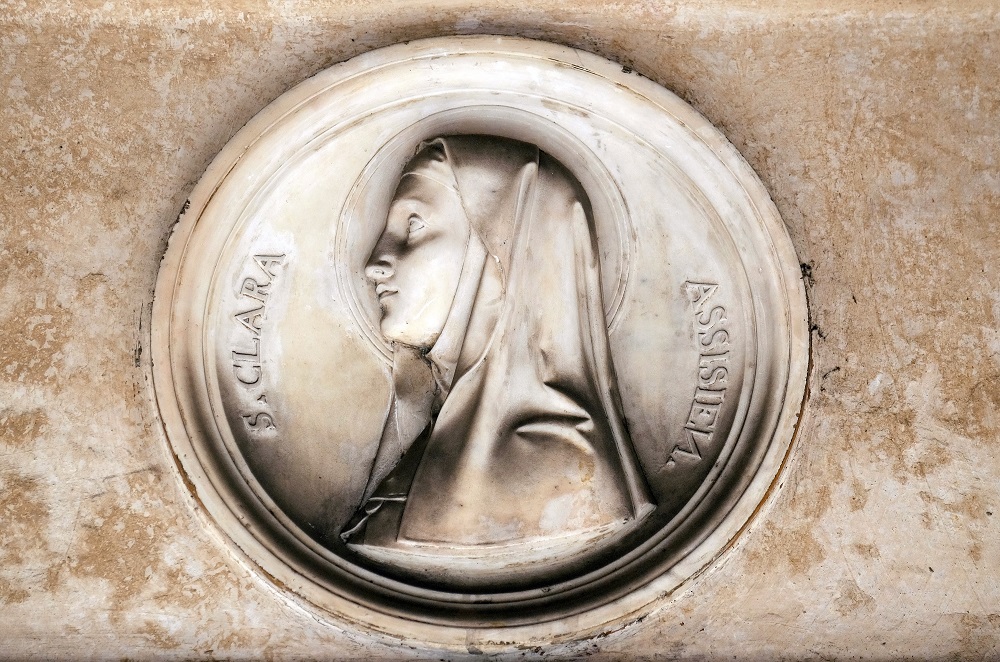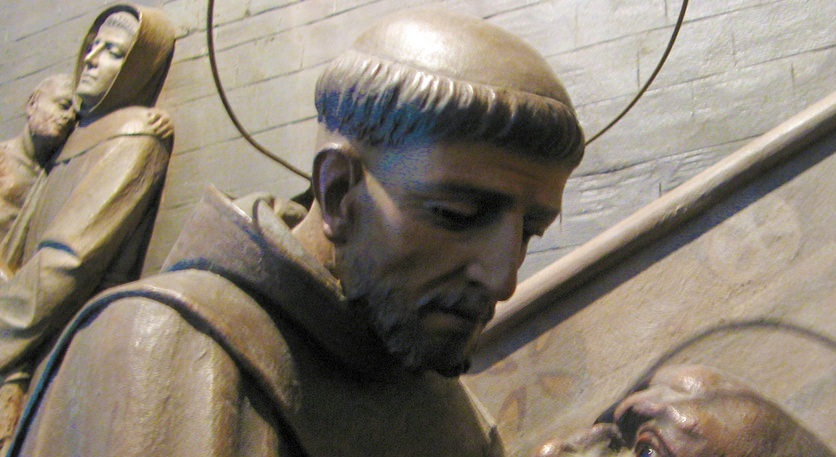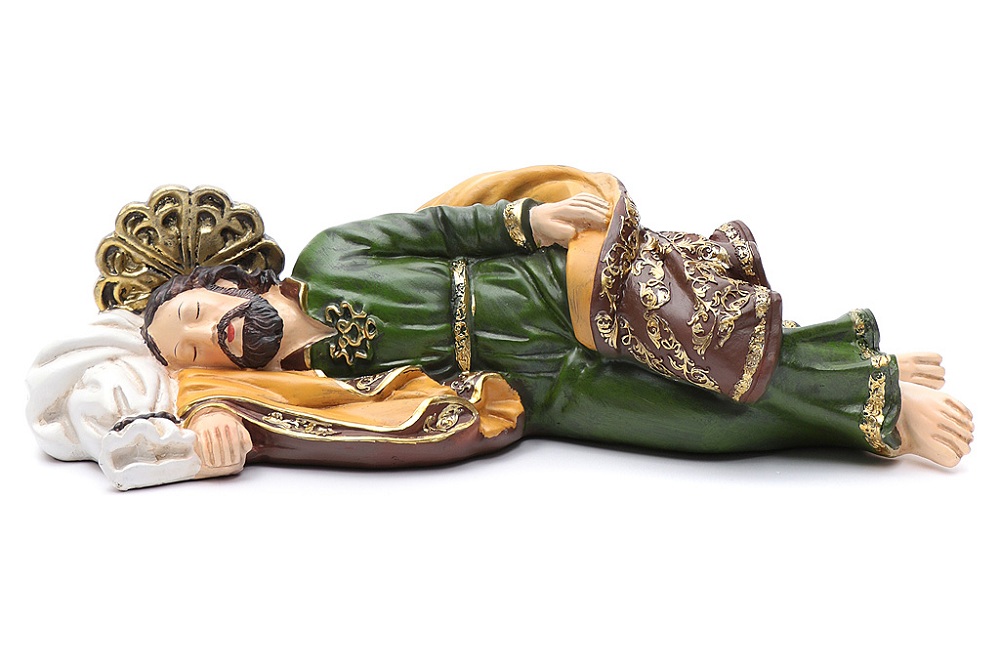Saint Clare followed the example of Saint Francis, renouncing all her possessions and sacrificing her young life to Jesus. This exceptional woman is celebrated on 11 August.
Contents
It is rare to hear the name of Saint Clare of Assisi without being associated with her name that of her fellow citizen and great friend Saint Francis.
The two young people were linked by a friendship so tender and profound that it became an integral part of their journey of faith and their mission in this land. We told of this special bond, which made God smile, when we spoke of the World Day of Friendship celebrated on 30 July.

World Day of Friendship
July 30 is the World Day of Friendship, a celebration born to celebrate one of the most wonderful aspects of coexistence between men.
But Saint Clare deserves to be remembered and celebrated not only under her unique and special bond with the poor man of Assisi. The courage and the spirit of sacrifice demonstrated by this girl who decided to leave all the privileges that her illustrious birth would guarantee her to embrace a lifestyle at the limit of poverty, are to be admired, beyond the inspiration that encouraged them. The same girl, belonging to one of the richest families and because of Assisi, will come to beg Pope Gregory IX to obtain the “privilege of poverty”.
This determination, this desire to dedicate one’s existence to a transcendent spiritual value, imitating Jesus to the point of feeling at one with him, are merits that Saint Clare could carry out alone.
This is not to forget that there have been women who have changed the church and the world, not necessarily with the help of men. Saint Clare, the founder of the Poor Clares, who became the patron saint of television and telecommunications, deserves to be considered one of them. This particular patronage, attributed to her in 1958 by Pope Pius XII, was born from the legend which Chiara could not participate in the Christmas Mass celebrated by Saint Francis because she was indisposed. The Mass would appear to her as a vision and with it even an angel who brought her the Eucharist that she could not otherwise receive.
Saint Clare and her encounter with Saint Francis
It remains true, however, that to arouse in her the religious fervour and rebellion against the wealthy future that the family had destined for her was almost certainly the gesture of that out-of-the-ordinary boy who in the winter of 1206 scandalised Assisi stripping himself of his rich clothes in the Bishop’s Palace, to return them to his father Pietro di Bernardone.
The boy was Saint Francis, and Clare was only twelve years old, but we like to think that on that day, before that inconceivable act consummated before all the Umbrian nobles, the germ of holiness took root in her. He certainly never forgot that boy, who continued to follow from afar, thanks to the accounts of Rufinus, one of the young men who followed Francis, who was also the girl’s cousin.

Saint Clare matured her choice of life and faith over the next seven years. We cannot speak of a reckless act dictated by simple emulation! Little do we know about her in those years, except that she was a shy child, brought to the contemplative life, and that she soon learned from her mother the dowry of charity.
Certainly, the young Francis provided her with the model of life and spiritual vocation that she finally decided to embrace. As soon as Clare was eighteen, she went to him for advice, and Francis was happy to help her escape from her home and family on the evening of Palm Sunday, 1211. Among the crumbling yet exuding walls, the spirituality of the Porziuncola Francis cut her hair and offered her the wisdom of her Franciscan brothers. With less clamour than her friend, but with the same courage, she made her choice of life and faith.
For some time Clare had to escape the insistence of the family, who wanted her back home. She took refuge in the Benedictine monastery of San Paolo della Abbadesse, in Bastia Umbra. It is said that her relatives even tried to kidnap her, especially after her sister Agnes decided to imitate her gesture and join her. Together they moved to San Angelo di Panzo, always chased by family members, but no threat, no flattery could convince the two girls to return in their footsteps.
Meanwhile, Francis and his brothers were preparing accommodation for Clare and Agnes in the Church of San Damiano, which kept the crucifix in front of which the young Saint had met his own conversion. It was right in front of that crucifix that Francis had received from the Lord the call to work to refurbish His church.

In the church of San Damiano, Saint Clare founded the “Poor Ladies of San Damiano”, the future Order of the Poor Clares.
A bond that united Saint Francis and Saint Clare
Clare and Francis were united by a deep friendship, which had nothing of the carnal love that can unite a man and a woman. An elective affinity is a spiritual bond made of esteem, respect, and constant mutual stimulation.
Together these two splendid young people looked in the same direction, and in that direction, they continued, animated by the common will to imitate and approach Christ day after day, step by step.
If looking in the same direction means loving each other, as has been written, then certainly Francis and Clare loved each other, uniquely and specially.
It was for Chiara that Francis sang his Song of the Creatures in the church of San Damiano, just before he died. The Song is at the same time prayer and a poem of love, where love is that for all the creatures of God, which Francis and Clare shared.

The Canticle of the Creatures of St. Francis
St. Francis of Assisi is one of the most loved and venerated saints by the Catholic Church.
A spiritual friendship, therefore, is made of sharing everything, from poverty to devotion, and finally to the path to holiness.
The order of the Poor Clares
Only after the death of Saint Clare did the “Poor Inmate Ladies of San Damiano” become the Poor Clares. The story of the order was not always easy. At that time it was believed that the only way for women to live their spirituality and dedicate their lives to God was through closure, spent in prayer and penance, completely detached from the world. But to be able to afford to live in this way, they needed to perceive some income.

Clare, who felt an integral part of the Franciscan order, could not accept to break the rule of Poverty embraced by her teacher and friend. In 1228 he obtained from Pope Gregory IX the bull called “Privilege of poverty”, under which she and her sisters could choose to possess nothing and to live on alms. But Clare had to fight her whole life to defend this privilege.
For a long time the monasteries of the Poor Dames, or Damianites, inspired by the one built in San Damiano, followed the rule imposed by Cardinal Ugolino d ‘Agnani, who demanded that the Dames refer directly to the Holy See, and not to the bishop, and which provided for very strict rules including a very strict closure, which could not be violated even after death. In fact, the Dames had to be buried inside the monastery where they had lived.
For the Convent of San Damiano, Clare wrote her own rule, which prevented his sisters from accepting donations and rents, but after her death, many monasteries did not follow it.
Pope Urban IV in 1263 wrote a new Rule, the first written by a pope for a female order, making uniform the jurisdiction of all the monasteries of the Dames or Poor Sisters, who from this moment became Poor Clares.
That of the Poor Clares later became the model of life for all cloistered nuns, also belonging to other orders.
Basilica of Santa Chiara
Clare died on 11 August 1253, and soon after her death, one began to think about the need to erect a church dedicated to her. The building work began at the church of San Giorgio, where the Saint had been temporarily buried. In addition to the Basilica dedicated to her, she also wanted to build a convent for the Poor Clares of San Damiano. The Basilica of Santa Chiara is made of Subasio stone worked in pink and white bands. The ceiling is supported by large rampant arches. With its unique nave and gallery that runs along the perimeter internally, it looks very much like the upper church of San Francesco. The Basilica of Santa Chiara in Assisi was consecrated on 6 September 1265 by Pope Clement IV.
In the chapel of San Giorgio, inside the Basilica, in addition to the remains of Saint Clare, the Crucifix of San Damiano is still preserved today, which inspired San Francesco and played a great part in this wonderful history of friendship and faith.

Crucifix of San Damiano
The Crucifix of San Damiano is the one in front of which St. Francis was intent on praying when, in the distant year of 1205, he received…


























